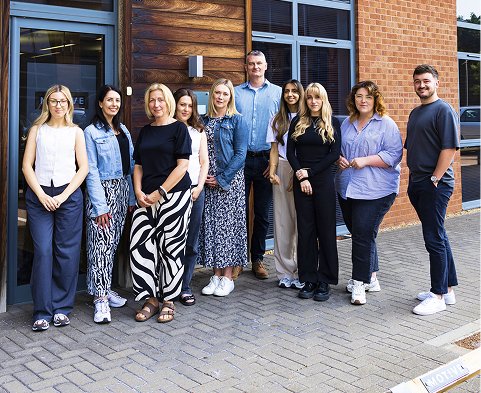Post-pandemic, the travel and tourism sector is experiencing a real resurgence. According to figures from the World Travel & Tourism Council, in 2024 the sector’s contribution to global GDP totalled $10.9 trillion (£8.6 trillion). This year that’s expected to reach an all time high of $11.7 trillion (£9.23 trillion)!
Here in the UK, figures from ABTA also highlight how well the sector is performing. Over the past 12 months, people took, on average, 3.9 holidays a year up on 3.4 from the previous year. However, the number of people travelling remains the same at 84%, although there has been a slight increase in those heading abroad. The challenge here for the industry is that while the overall demand for holidays has been strong, the group of ‘habitual holidaymakers’ are just travelling more frequently.
.jpg)
So how does the sector reach out to those who are travelling less often or not at all, taking into account the current economic climate? And in a market that is so competitive, how does a brand stand out from the crowd? Well, that’s where PR as part of an integrated PR and marketing strategy comes into play.
Whether your goal is brand awareness, is focused on SEO rich backlinks or is all about being mentioned in AI Overviews, PR should play an integral role in your overall marketing strategy. It’s your chance to control the narrative but at the same time be creative, have fun and react quickly to breaking news and trends.
Seasonality will play a pivotal role. PR campaigns will need to align with consumer travel cycles, school holidays, weather patterns, and cultural events. A well-planned approach can help businesses maximise visibility in peak seasons, capitalise on quieter months, and stay front-of-mind all year round.
This blog will explore exactly how to do that by showing you how to map your PR activity to the seasons, develop compelling news hooks, leverage off-peak opportunities, use data to drive stories and react to fast-moving news.
The strategies here will help you position your travel brand as both a trusted source of insight and an essential part of the traveller’s journey whatever the time of year.
What’s in this article:
- What do we mean by seasonality in PR?
- Why seasonality is important in travel PR
- Six tips for leveraging seasonality in travel PR
- Creating a seasonal calendar
- Developing news hooks
- Off peak story telling
- Data lead content
- Case studies
- Reactive PR
- Key takeaways
What do we mean by seasonality in PR?
When we talk about seasonality in PR, what we’re referring to is planning campaigns and stories around the natural peaks and troughs in interest and demand throughout the year. For travel, this means aligning content with high season or off-peak times to ensure your campaigns hit when journalists and audiences are most receptive.
It also involves identifying timely hooks like cultural events, trending topics, or pop culture moments that can make a story more compelling. This is why PR teams must understand seasonality and how it applies to their brand or clients – it allows them to maximise coverage and maintain visibility throughout the year.
Why seasonality is important in travel PR
Seasonality is crucial when it comes to travel PR. It can provide a focus for campaigns and great story hooks. Here’s why it matters so much:
Timing and relevance
Getting the timing right makes journalists more receptive to your stories and campaign ideas. For example, pitching a ski feature in late summer works well for long-lead publications, while the same story can be repurposed for online titles and news sites during winter. Aligning your campaigns with editorial calendars is key to maximising impact.
Maximising impact in peak season
High season brings the fiercest competition, so PR campaigns need to be strong, relevant, and offer journalists something extra, such as unique data or fresh insights.
Balancing low season
Even in the low season, there are plenty of PR opportunities. What unique experiences or hidden gems can you showcase? People travel year-round, so there are always stories to tell.
With the right PR tools and planning, your campaigns can run smoothly throughout the year.
Six tips for leveraging seasonality in travel PR
Timing is everything in PR, and understanding how to work with the seasons can make all the difference. From peak periods to quieter months, knowing when and how to pitch stories ensures your campaigns are relevant, attention-grabbing, and more likely to secure coverage. Here are six practical tips to help you make the most of seasonality in your PR strategy.
.jpg)
1. Create a seasonal calendar
Think of a seasonal calendar in travel PR as your go-to roadmap for the year. It lays out tourism demand and promotional opportunities so you know exactly when to pitch what. It breaks down peak, shoulder, and low seasons for a destination or niche, based on things like weather, school holidays, cultural events, and traveller habits.
For example, a European coastal resort might see June-August as the high season for beach holidays, April-May and September-October as shoulder seasons for food or culture trips, and November-March as low season for wellness retreats or off-season deals.
Having a seasonal calendar in place is a game-changer for PR and marketing. It helps you time campaigns perfectly, whether you’re pitching long-lead magazines six months ahead of peak season or creating reactive content for news sites on the day.
With it, your PR campaigns stay fresh, make the most of both busy and quieter periods, and keep your brand top of mind all year round.
2. Develop news hooks
Once you have your seasonal calendar in place, it’s time to get creative and develop interesting news hooks to appeal to travel writers and mainstream journalists. The seasonal calendar will provide a wealth of story suggestions including:
Seasonal trends
Seasonal trends can inspire a whole host of stories, from hidden gem destinations to insights on customer booking habits. Story hooks could range from “the top destinations for UK holidaymakers this summer” to “the best budget-friendly ski resorts”, for example.
Holidays and events
Are there major holidays or events you can tie a story to? For example, at Christmas you might create content on the best Christmas markets to visit on a budget. Or for Valentine’s Day, why not highlight the most unusual but romantic destinations for a memorable proposal?
Travel planning cycles
Think about when people typically book their holidays. For example, the New Year is a popular time for planning summer getaways, making it the perfect moment to pitch content on summer destinations.
Pop culture
Could pop culture give your story a boost? Think about hit shows on streaming services – is there a destination tied to one of them that you could feature? In recent years, series like The Crown have been perfect for this kind of angle.
Wider news agenda
Keep an eye on the news agenda for story hooks too. For example, the ‘cost of living’ crisis has influenced holiday bookings, creating angles around budget-friendly travel. Or consider over-tourism – could you highlight lesser-known destinations that travellers should explore instead?
3. Consider off-peak story telling
The off-peak or shoulder season for the travel and tourism sector is still rich with PR opportunities - after all, who doesn’t love to travel regardless of the time of year? Among the hooks you could explore:
Niche destinations and experiences
The off-season is the perfect time to shine a light on niche destinations and experiences. For example, you could create content around wellness escapes – these stories aren’t just great for travel and lifestyle outlets, they’ll also appeal to health and wellness writers. If your PR focus includes building backlinks for SEO, the off-season is ideal for reaching new domains and niche publications.
Value offering
Out of season destinations provide an opportunity to create content around a value offering and highlight other attributes of an area. It’s a chance to showcase different destinations and put them on the map when they’re not busy.
Cultural hooks
There may be local traditions and cultural events travellers miss. Think film festivals, local fiestas or food festivals to hook a story onto. A round up of the best film festivals can work for travel and popular culture press whereas a food festival could work for food and drink titles. Great targets for brand awareness and backlinks.
4. Data led content
Journalists love data. Offering them unique data wrapped up in an interesting and relevant story is too good an opportunity for them to miss. Use original research on search trends, booking patterns, or traveller preferences. Update these numbers each year, and you’ve got a series of compelling stories showing how trends and behaviours are evolving. Some examples of data-led content include:
Booking and pricing trends
Consider developing a monthly tracker showing where hotel and flight prices have fallen and risen. As well as creating strong news hooks, this is a good resource to sit on your website for journalists to use.
Seasonal shifts
Explore how buying behaviour has changed - do people book earlier now compared to five years ago for example? Think too about the length and frequency of holidays. Your data may show people are travelling more frequently but on shorter breaks. This offers a unique insight into behaviours.
Destinations
Based on year-on-year figures from your brand, you can identify destinations rising in popularity, those people are visiting less frequently. You may be able to link this to the news agenda. Consider protests in Spain around over-tourism or rising tourist tax charges across Europe and further afield.
Themed Indexes
Indexes are sets of data you can create yourself by looking at different variables. For example, we created the Stressful Airport Index for an international car rental client. By taking into account various factors including number of destinations served, parking options, departure delays and distance to the city centre we were able to produce unique data highlighting Europe's most stressful airport and the most stressful in the USA. Both secured extensive coverage for the brand.
5. Case studies
Case studies can be really useful as they create human stories other consumers can relate to. The key is finding a strong hook, telling a good story and having a strong bank of images to support it.
It will give journalists something more engaging to work with than a straight press release, offering a human face, authentic quotes, and a clear story. Case studies can also add depth to wider pieces.
The ultimate goal is to transform dry information into a compelling story that people want to read, share and experience for themselves.
6. Reactive PR
Reactive PR and newsjacking is extremely effective for the travel sector because it’s so fast moving and journalists will need expert commentary and input frequently.
There are often strong news stories to react to. It could include airline delays, issues at airports in the UK and overseas impacting travellers, the impact of extreme weather changes to name a few.
The key is to be able to react quickly. Turnaround for rolling news stories is fast. If your brand is able to provide relevant comments to a tight deadline, the more likely the journalist will come back to you again. All great for raising your brand profile and being seen as the experts in your field.
Key takeaways:
- Seasonality should guide PR strategy. Aligning campaigns with peak, shoulder, and low travel seasons ensures maximum relevance, stronger journalist interest, and year-round brand visibility.
- A seasonal calendar is a vital planning tool. Mapping demand, events, and booking cycles allows PR teams to prepare long-lead pitches, timely content, and reactive stories with precision.
- Compelling hooks boost coverage. Seasonal trends, major holidays, pop culture references, and topical news items provide rich opportunities for creative travel storytelling.
- Off-peak travel offers unique PR potential. Niche destinations, value-driven packages, and cultural events during quieter months can generate strong media interest and brand differentiation.
- Data and case studies enhance credibility. Original research, booking trends, themed indexes, and human-interest case studies give journalists compelling, trustworthy content that positions a brand as an expert voice.
If you need support for your travel brand, please get in touch.



.jpg)

.jpg)
.jpg)


.jpg)

